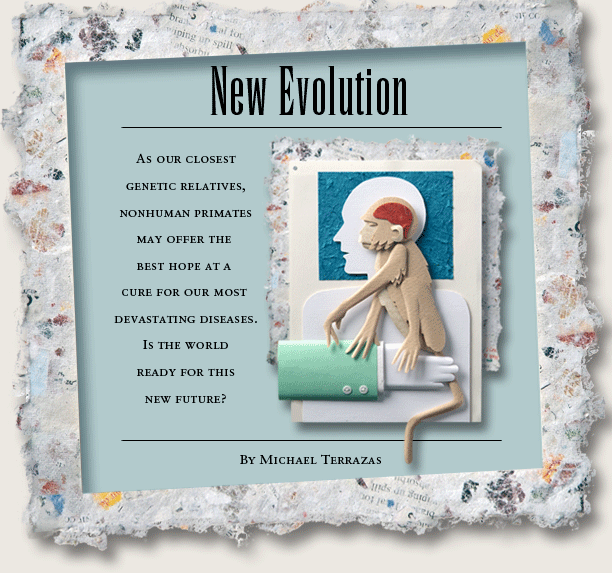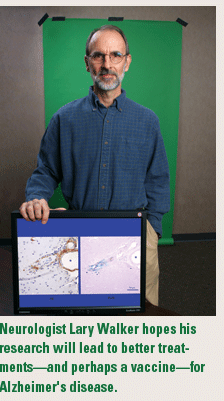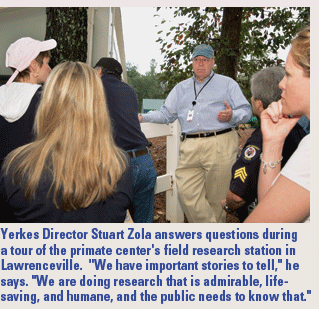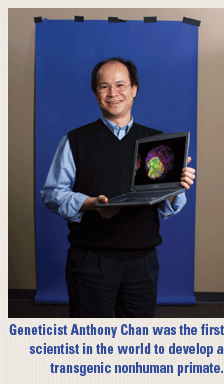














|
 |
| |
 |
|
 |
 o
the untrained eye, the pictures on physicist Timothy Duong’s
computer screen don’t look like much—softball-sized
globes of wrinkled gray matter flecked with bright spots of color.
But these images—MRI scans of the brains of rhesus macaques—may
hold the key to a revolution in modern medicine. o
the untrained eye, the pictures on physicist Timothy Duong’s
computer screen don’t look like much—softball-sized
globes of wrinkled gray matter flecked with bright spots of color.
But these images—MRI scans of the brains of rhesus macaques—may
hold the key to a revolution in modern medicine.
“We have MRI, functional MRI
(fMRI), micro PET, and other modalities such as optical retina imaging,”
Duong says, showing off Yerkes’ Neuroscience Research Facility
like a first-time homeowner. The $27 million building, with the only neuroimaging
center in the country devoted to nonhuman primate studies, serves
as home base for one of Yerkes’ expanding research frontiers:
the brain.
first-time homeowner. The $27 million building, with the only neuroimaging
center in the country devoted to nonhuman primate studies, serves
as home base for one of Yerkes’ expanding research frontiers:
the brain.
Why house so much imaging power at
a primate center?
“Most researchers must transport
animals to an off-site facility—usually one dedicated to imaging
human patients,” says Duong. “And then they don’t
have access to the level of imaging and degree of specialization
we have here to monitor brain development and function.”
This ability will be key as the center
embarks on a new research endeavor.
Within the next four years, Yerkes
geneticist Anthony Chan hopes to develop the first transgenic nonhuman
primate model for inherited neurodegenerative diseases. If he is
successful, the new imaging technologies will allow researchers
to study changes in the brain in a way that has never been possible
before.
Chan, who developed the world’s
first transgenic nonhuman primate at Oregon Health & Science
University in 2000 (a monkey with a jellyfish gene inserted into
its DNA), was recruited by Emory in 2002 to pursue a new goal: developing
a primate model for Huntington’s disease.
The disease does not normally occur
in rhesus monkeys, but if the human genes associated with Huntington’s
can be inserted in the animals, then the neurologic changes caused
by the disease can be studied more effectively.
Eventually, Chan’s studies will
examine the entire spectrum of the disease, from detecting what
makes the transgenic monkeys susceptible to illness, to studying
the disease’s onset and progression using functional MRI to
monitor changes in the brain. |
 |
| |
 |
|
 |
A
breed apart |
|
 |
As
Yerkes celebrates its 75th anniversary, Chan’s research is
just one example of how the center is at the forefront of an emerging
era in biomedical research. Called by many different names—genomic
medicine, predictive health, or predictive medicine—this new
age is one in which scientists believe they will be able to determine
who will get certain diseases simply by looking at a person’s
genome—the genetic code that governs physical development.
And many are predicting the early
advances in this new, gene-based medicine will be seen in neuroscience.
At the April 8, 2005, Futurist Forum—a
gathering of visionaries from around the nation who weighed in on
Emory University’s strategic planning process—one speaker
quipped, “When I first met Mike Johns, I told him the School
of Medicine should be renamed the School of Neuroscience, because the
brain is the commanding organ of the body—medical health starts
with brain health,” said Floyd Bloom, professor emeritus at
the Scripps Research Institute and former president of the Society
for Neuroscience.
Medicine should be renamed the School of Neuroscience, because the
brain is the commanding organ of the body—medical health starts
with brain health,” said Floyd Bloom, professor emeritus at
the Scripps Research Institute and former president of the Society
for Neuroscience.
And in this new era of medicine, says
Yerkes Director Stuart Zola, brain health research will start not
with neurologists and human patients but with nonhuman primates.
“Yerkes intends to be established
as a world leader in neuroscience research,” Zola says matter-of-factly.
“We have a convergence of so many research capabilities that
are going to be important for understanding how the brain is organized,
how brain function translates to behavior, and what that really
means.”
In addition to Chan’s work,
Lary Walker, research professor in neurology, plans to use transgenic
models to research diseases like Alzheimer’s and Parkinson’s.
“No organisms except humans
develop Alzheimer’s disease,” Walker says. “We
want to find out what is different between a rhesus monkey and a
human that results in the human getting the disease while the rhesus
doesn’t.” |
 |
| |
 |
|
 |
Out
of the shadows |
|
 |
Taking
on this brave new research world has required something of a fundamental
climate change within Yerkes. The center has been accustomed to
serving a vital, yet largely hidden role in fostering medical advances.
“When I arrived here, there
was a tendency to try to keep Yerkes off everyone’s radar,”
says Zola, the center’s director since 2001. That old conventional
wisdom had been shaped by years of animal rights protests, some
ending literally at Yerkes’ front gate. This was not the kind
of publicity center directors wanted, and so they avoided attention
altogether.
But now an entirely different approach
is needed, Zola believes. The advances in genomic medicine have
been accompanied by new challenges to medical research and to nonhuman
primate research in particular, he says. If the promise of this
new science is to be realized, the public must understand the value
of the research conducted at Yerkes and the consequences for humankind
if the work is restricted.
“We need to be proactive,”
he says. “We need to be aggressive about our profile in the
community. We have important stories to tell. We’re doing
research that is admirable, lifesaving, and humane, and the public
needs to know that.” |
 |
| |
 |
|
 |
Survival
of the fittest |
|
 |
The
push of this new scientific momentum comes at a time when nonhuman
primate research is facing new challenges.
In September 2005, a group of international
scientists announced the completion of the mapping of the chimp
genome, which relied on DNA from a Yerkes chimpanzee. Chimps and
humans share 98% of their genetic makeup, making chimps an ideal
model for studying human neurologic development. This year, scientists
also expect to finish mapping the genome of the rhesus macaque,
the most widely used nonhuman primate in science.
Mapping of the chimp genome was greeted
with understandable excitement in the scientific community. The
entire September 2005 issue of the journal Nature was devoted to
coverage of its implications. But it also raised new questions—even
among some scientists—about the ethics of conducting certain
experiments on great apes. Few other countries permit the use of
chimpanzees in biomedical research. |
 |
 |



|
 |
 |
Zola
believes too many people are unaware of the important role chimps
have played in many of the important medical discoveries of the
past two decades, including helping scientists understand the basic
makeup of HIV and how it infects cells and the development of a
vaccine for hepatitis B.
More recently, chimpanzees have been
vital to testing monoclonal antibodies—genetically engineered
agents that are almost identical to naturally occurring antibodies,
cells our immune systems develop to fight infection. These antibodies
one day may be used to “vaccinate” people against different
cancers and autoimmune diseases.
Now that we know the extent to which
chimpanzees are genetically similar to humans, their research potential
is even greater, says Zola. With both the chimp and human genomes
sequenced, comparisons between the two are being used to identify
genetic links to diseases that uniquely affect people.
And those are just the research avenues
already under way, Zola says. “It’s very likely within
the next few decades that we will discover more.”
Thirty-five years ago, it would
have been impossible to predict that chimpanzees would hold the
key to understanding the basis of AIDS or hepatitis B and C because
the viruses that cause those illnesses had not been discovered yet,
he points out. Now, advances in genetic and molecular research are
rapidly delineating new treatment possibilities, many of which were
unheard of a decade ago.
It’s essential that researchers
who work with primates become more vocal and active to ensure that
the scientific benefits of research are weighed along with its challenges,
Zola says.
It’s one of the reasons he accepts
outside speaking engagements and encourages other Yerkes scientists
to serve on speaker’s bureaus and do other forms of advocacy
in their areas of specialization, giving primate research a higher
level of visibility. |
 |
| |
 |
|
 |
Evolved
leadership |
|
 |
It
also helps that the Woodruff Health Sciences Center is visibly committed
to supporting the work at Yerkes, including it at a level on par
with the center’s other academic components—the schools of medicine, nursing, and public health.
components—the schools of medicine, nursing, and public health.
“The three deans and I all sit
at Mike Johns’ table for executive leadership,” says
Zola. “None of the other seven national primate research centers
have that kind of reporting organization.”
And there are signs the evolution
in communication strategy is working in support of the potentially
revolutionary research under way at Yerkes. Although diminished
in number, animal rights protesters were back again last spring,
carrying placards and shouting personal insults at animal researchers.
But for the second year in a row, supporters of animal research
staged a counter-protest to balance the equation.
A result of Zola’s aggressive
PR campaign, perhaps? He sure thinks so.
“I like to attribute the lack
of enthusiasm in these animal rights demonstrations to the fact
that the public has begun to understand what we do and why it’s
important,” he says. “As long as we make it clear that
we are serious about our stewardship of the welfare of the animals
and we are definitive about our successes, there’s support
to do this research. We will continue to tell our story in a clear
and truthful way.”
Michael
Terrazas is editor of Emory Report. |
 |
| |
 |
|
 |
| |
 |
|
 |
75
Years of Discovery |
 |
| |
 |
|
 |
The
expanded focus on neuroscience doesn’t
mean Yerkes is reducing the broad array of research that put
the center on the map long ago—research like that of
world-renowned primatologist Frans de Waal, whose studies
of primate social interactions recently earned him induction
into the National Academy of Sciences. Or that of psychobiology
chief Mark Wilson, who examines how hormones affect adult
social behavior. Transplant surgeons Christian Larsen and
Thomas Pearson are continuing to break new ground in developing
medications to prevent organ rejection. Georgia Research Alliance
Eminent Scholar Mike Kuhar is working on potential treatments
for cocaine addiction. And researcher Mike Mustari’s
work on nerve function and visual development may one day
help physicians preserve the sight of children born with congenital
eye diseases.
Harriet Robinson, Yerkes’
chief of microbiology and immunology, who was recruited eight
years ago from Boston University, is continuing her effort
to develop a DNA vaccine to fight AIDS. Robinson’s two-step
vaccine (a DNA prime and a recombinant poxvirus as a booster)
has been in Phase I clinical trials for three years. Robinson
says it could be 2012 at the earliest before any vaccine is
ready for humans, but she estimates that Phase III efficacy
trials could come as soon as 2009.
“There are 20 to 25 AIDS
vaccines in development around the United States, and none
has preclinical data as strong as ours,” she says. Robinson
credits the foundation of knowledge that exists among Yerkes
scientists for helping advance her own work, and that synergy
could in the not-too-distant future break down even more disciplinary
walls. For example, might Yerkes someday be involved in developing
a vaccine for Alzheimer’s?
“A few years ago there
was a big splash about immunization therapy for Alzheimer’s,”
says neurology researcher Lary Walker, adding that human trials
of a vaccine ended when enrolled patients began developing
encephalitis. But the approach still holds promise. Walker
is using squirrel monkeys to continue Alzheimer’s immunization
studies, with some preliminary success.
The ability of faculty at Yerkes
to work across disciplines and collaborate with each other,
as well as with researchers throughout the Health Sciences
Center and on national and international levels, will be key
in achieving many of these goals.
“Collaborations like these
are the kinds of critical processes that differentiate institutions
that produce Nobel Prize winners from those that don’t,”
says Yerkes director Stuart Zola. “Institutions that
foster Nobel Prize winners don’t necessarily have better
labs or the latest equipment—what they have are places
that nurture interdisciplinary thinking in order to look at
issues in a new and bold way.” |
 |
| |
 |
|
|
 |
| |
 |
|
| |
|
|
|
|





